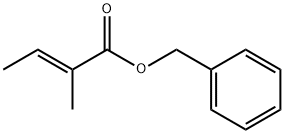BENZYL TIGLATE
- CAS NO.:37526-88-8
- Empirical Formula: C12H14O2
- Molecular Weight: 190.24
- MDL number: MFCD00017279
- EINECS: 253-544-8
- SAFETY DATA SHEET (SDS)
- Update Date: 2024-12-18 14:15:32

What is BENZYL TIGLATE?
Chemical properties
Colorless liquid. Insoluble in water, soluble in alcohol and oils.
Occurrence
Reported found in clove bud and rose apple (Syz. jambos Alston).
The Uses of BENZYL TIGLATE
Tiglic Acid Benzyl Ester is found as one of the Geranium essential oils, and essential oil and solvent extracts of Iris planifolia (Mill) from Algeria, possessing antibacterial activity. It is also the starting material in the synthesis of (S)-α-Acetolactic Acid (A163805).
Preparation
By direct esterification of tiglic acid with benzyl alcohol under azeotropic conditions.
Definition
ChEBI: Benzyl trans-2-methyl-2-butenoate is a carboxylic ester. It is functionally related to a benzyl alcohol.
What are the applications of Application
Benzyl tiglate has been suggested for use in Rose fragrances, where this particularly deep-earthy, almost musty undertone can be desirable, e.g. in combination with spicy undertones. This ester also introduces a certain naturalness of herbaceous character, and blends well with Vetiver oil, Oakmoss, etc. in Reseda and similar fragrance types. Suggested for use in Rose type fragrances. mainly as a background note and fixative.
Taste threshold values
Taste characteristics at 100 ppm: sweet, balsamic, spice-like with a nutty almond note.
Properties of BENZYL TIGLATE
| Boiling point: | 139 °C9 mm Hg(lit.) |
| Density | 1.031 g/mL at 25 °C(lit.) |
| refractive index | n |
| FEMA | 3330 | BENZYL TRANS-2-METHYL-2-BUTENOATE |
| Flash point: | >230 °F |
| form | clear liquid |
| color | Colorless to Almost colorless |
| Odor | at 100.00 %. balsamic earthy mushroom vegetable plastic cortex almond nutty |
| JECFA Number | 846 |
| BRN | 2556119 |
| CAS DataBase Reference | 37526-88-8(CAS DataBase Reference) |
| EPA Substance Registry System | 2-Butenoic acid, 2-methyl-, phenylmethyl ester, (2E)- (37526-88-8) |
Safety information for BENZYL TIGLATE
| Signal word | Warning |
| Pictogram(s) |
 Exclamation Mark Irritant GHS07 |
| GHS Hazard Statements |
H315:Skin corrosion/irritation H319:Serious eye damage/eye irritation H335:Specific target organ toxicity, single exposure;Respiratory tract irritation |
| Precautionary Statement Codes |
P261:Avoid breathing dust/fume/gas/mist/vapours/spray. P304+P340:IF INHALED: Remove victim to fresh air and Keep at rest in a position comfortable for breathing. P305+P351+P338:IF IN EYES: Rinse cautiously with water for several minutes. Remove contact lenses, if present and easy to do. Continuerinsing. P405:Store locked up. |
Computed Descriptors for BENZYL TIGLATE
New Products
(S)-3-Aminobutanenitrile hydrochloride 4-Methylphenylacetic acid N-Boc-D-alaninol N-BOC-D/L-ALANINOL Tert-butyl bis(2-chloroethyl)carbamate 3-Morpholino-1-(4-nitrophenyl)-5,6-dihydropyridin- 2(1H)-one Furan-2,5-Dicarboxylic Acid Tropic acid 1-Bromo-3,5-Di-Tert-Butylbenzene S-2-CHLORO PROPIONIC ACID ETHYL ISOCYANOACETATE 2-Bromo-1,3-Bis(Dimethylamino)Trimethinium Hexafluorophosphate 4-IODO BENZOIC ACID 3-NITRO-2-METHYL ANILINE 1-(2,4-DICHLOROPHENYL) ETHANAMINE (2-Hydroxyphenyl)acetonitrile 4-Bromopyrazole 2-(Cyanocyclohexyl)acetic acid 4-methoxy-3,5-dinitropyridine 1-(4-(aminomethyl)benzyl)urea hydrochloride 2-aminopropyl benzoate hydrochloride diethyl 2-(2-((tertbutoxycarbonyl)amino) ethyl)malonate tert-butyl 4- (ureidomethyl)benzylcarbamate Ethyl-2-chloro((4-methoxyphenyl)hydrazono)acetateRelated products of tetrahydrofuran








You may like
-
 Benzyl Tiglate CAS 37526-88-8View Details
Benzyl Tiglate CAS 37526-88-8View Details
37526-88-8 -
 2033-24-1 98%View Details
2033-24-1 98%View Details
2033-24-1 -
 1975-50-4 98%View Details
1975-50-4 98%View Details
1975-50-4 -
 2-HYDROXY BENZYL ALCOHOL 98%View Details
2-HYDROXY BENZYL ALCOHOL 98%View Details
90-01-7 -
 2-Chloro-1,3-Bis(Dimethylamino)Trimethinium Hexafluorophosphate 221615-75-4 98%View Details
2-Chloro-1,3-Bis(Dimethylamino)Trimethinium Hexafluorophosphate 221615-75-4 98%View Details
221615-75-4 -
 61397-56-6 CIS BROMO BENZOATE 98%View Details
61397-56-6 CIS BROMO BENZOATE 98%View Details
61397-56-6 -
 14714-50-2 (2-Hydroxyphenyl)acetonitrile 98+View Details
14714-50-2 (2-Hydroxyphenyl)acetonitrile 98+View Details
14714-50-2 -
 118753-70-1 98+View Details
118753-70-1 98+View Details
118753-70-1